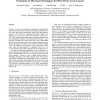Free Online Productivity Tools
i2Speak
i2Symbol
i2OCR
iTex2Img
iWeb2Print
iWeb2Shot
i2Type
iPdf2Split
iPdf2Merge
i2Bopomofo
i2Arabic
i2Style
i2Image
i2PDF
iLatex2Rtf
Sci2ools
ICCAD
2003
IEEE
2003
IEEE
Evaluation of Placement Techniques for DNA Probe Array Layout
DNA probe arrays have emerged as a core genomic technology that enables cost-effective gene expression monitoring, mutation detection, single nucleotide polymorphism analysis and other genomic analyses. DNA chips are manufactured through a highly scalable process, Very Large-Scale Immobilized Polymer Synthesis (VLSIPS), that combines photolithographic technologies adapted from the semiconductor industry with combinatorial chemistry. Commercially available DNA chips contain more than a half million probes and are expected to exceed one hundred million probes in the next generation. This paper is one of the first attempts to apply VLSI CAD methods to the problem of probe placement in DNA chips, where the main objective is to minimize total border cost (i.e., the number of nucleotide mismatches between adjacent sites). We make the following contributions. First, we propose several partitioning-based algorithms for DNA probe placement that improve solution quality by over 4% compared to ...
DNA Placement Algorithms | DNA Probe Placement | Hardware | ICCAD 2003 | Probe Placement Algorithms |
Related Content
| Added | 16 Mar 2010 |
| Updated | 30 Aug 2010 |
| Type | Conference |
| Year | 2003 |
| Where | ICCAD |
| Authors | Andrew B. Kahng, Ion I. Mandoiu, Sherief Reda, Xu Xu, Alexander Zelikovsky |
Comments (0)


